
Illustrations of Carthaginian hoplites, G.Rava, J. Schumate, Hook and... me
Fundation of Carthage
Carthaginian warfare existed as long as there was a city funded in the area of what is today Tunis. Carthage or "Kart-Hadast" meaning "New City" in semitic Phoenician. The Phoenicians were, before the Greeks, the first merchant maritme Empire, before the Greeks. They invented modern shipbuilding techniques and the concept of Emporios or merchant ports, dotting the Mediterranan with a solid network of trading routes and support. First great seafarers, the Phoenicians established trade routes as far as the Equatorial African coast (see Hanno's trips) and possibly modern Wales or southern Ireland, the "copper islands", Cassiteride country. Their epire stretched from their original hopland in modern palestine and Lebanon, especially around the three great city-states of Tyre, Biblos and Sidon, which were the exit gateway or end point of middle-eastern trade roads like the ancestor of the incense and sild roads, running through Persia up to India and China. This merchant Empire (which probably inspired Athens) was the first of its kind and Carthage, funded in 814 BC (with the associated legend of goddess Dido) was just one of the Emporios or merchant colony. But its strategic location, right at the hinge between eastern and western mediterranean, made it quite suitable to create a sub-empire of its own, on the both african coast, now encompassing Maghreb or Tunisia, Algeria and Morocco. <- A famous piece of hardware, the armor breastplate attributed to Carthaginians in Spain, about 250 BC.
<- A famous piece of hardware, the armor breastplate attributed to Carthaginians in Spain, about 250 BC.The army proper was formed by Mago I of Carthage, first King of Carthage in 550 BC. He wished not only some military independance from the mother city, Tyre, but also for Carthage to be the dominant military power in the western Mediterranean. For two centuries, Rome was a small backwater trapped between Carthage allied with the Etruscans (northern Italy) against rival Greek city-states of southern Italy and Syracuse. Indeed, Mago's reforms were to copy the army of Timoleon, Tyrant of Syracuse, therefore adopting or consolidating this greek style of warfare. We known very little indeed about pre-Greek Carthaginian warfare. For that the surest way would have been to have a look on the old Phoenicin warfare, practiced by Tyre, Biblos and Sidon.

Bas-relief depicting Carthaginian hardware, hardened composite leather armor and presumably bronze or painted hoplon shield.
Conquering the hinterland
However if the coast was only populated by small fishing villages, the hinterland was dominated by fiercely independent tribes and constituted Kingdoms. To say the least, between the Libyan tribes in the west, which were experts at bimaschia ('two-mounted') on camels over large distances, and the Numidians, both Massyli and Massassyli were expert horsemen and skirmishers, or the foggy Moors on further west, and the fierce Garamantes and Gaetuli in the deep south, the first decades were probably not easy. Plus there was one ancient Greek Emporio nearby which was already a rival in this par tof Africa, between Carthage and Egypt: Cyrta. Who knows if the latter was not an influence on the Carthaginians, especially on warfare. After the conquest of Persia in 327 BC by the Macedonians, for the entire Mediterranean, Greek warfare was the model to follow.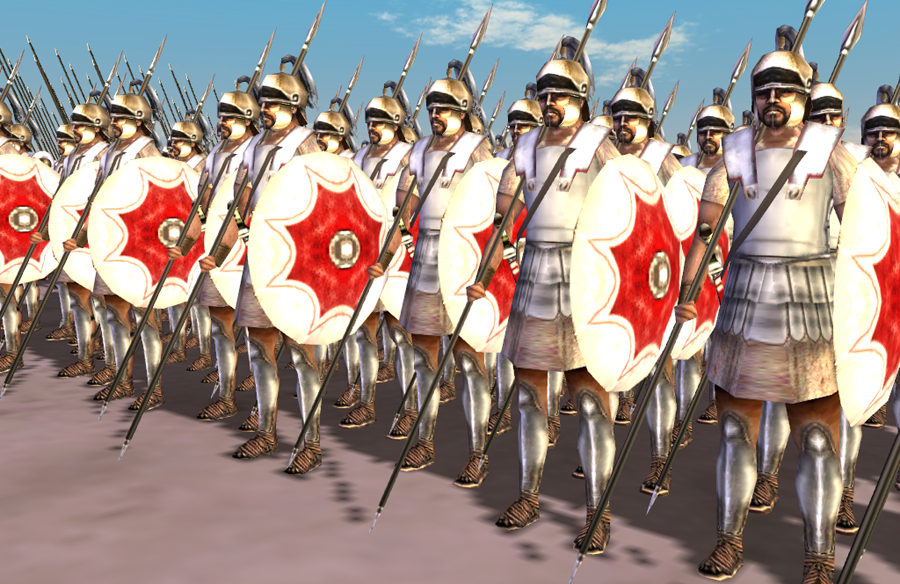
catw's Depiction of ancient libyan hoplites. Although most of these were of low extraction, raised from the nearby countryside, lots of Libyans of upper class, or mixed-race (Liby-Punic) lived also in coastal Punic cities. In that case they were likely equipped in the Hoplitic fashion, but still, with their lower social condition, their level of equipment was lilely inferior to upper class Carthaginian citizens, and especially picked-up units, like the Sacred band. Greaves were probably an option, as well as a sword or even a basic protection like a light leather one. Helmets could have been made of hadened leather as well. In that case, their shape is lost to history.
About the hoplitic model
Phalanx as a formation could be traced back right to the Sumerians, as depicted in a few bas-reliefs. They fought in close formation with large shields and chariots. That kind of formation required thinking, training, and was probably unique to the City-states, that can afford that luxury. Against horde-like tribes, they were sure winners. This legacy was passed on new civilization, with varied success. But none was successful using this formation before than the Greeks. Greek city-states indeed starting around 700 BC invented the concept of the hoplite. The name came from the typical bowl-shaped shield, which evolved from centuties of practice. At the origin it would have been likely flatted, with a single central handle, and the spear, shorter, about two meters long.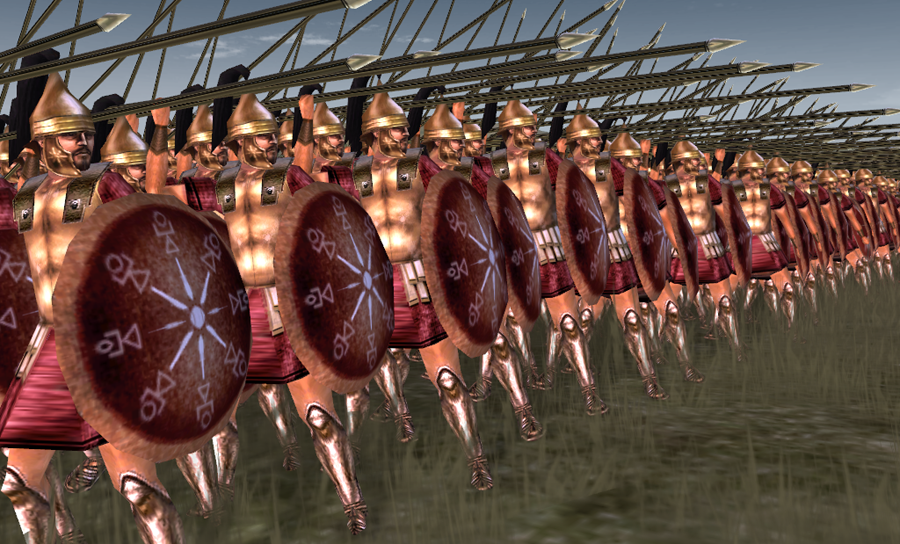
catw's Depiction of ancient Liby-Punic hoplites. The one characteristic item was their pointed helmet. But in a more realistic view, diversity would have seen them equipped with Greek helmets as well. This pointed model was typical of this region and could also be seen on the late Numidian infantry (up to Massinissa's rebellion).
But in the 5th century BC, this formation was now mature. The bowl-shape gave room to protect the arm that was firmly strapped in two points, the central handle now being a strap for the forearm and the handle replaced on the side, so that it was vitually impossible to separate the shield from his owner. Plus, the shield's rim can be used agressively in combat. The round shape and size (one meter) was refined to fit the type of formation use. In this close phalanx, almost shoulder to shoulder, each hoplite's shield covered his neighbour left flank. But the hoplon came from a more archaic model called the argive shield, which had two apertures either sides of the center for underhand spear handling. It seems the overhand handling gave better results and perhaps not only dictated the final shape of the shield, uniform, but also the lenght of the spear, now of three meters. This was also the longest possible when using one hand.


Rome II (vanilla) and EB II below depictions of Carthaginian hoplites. Between the pointy helmets, white color and numerous decoration patterns, this rendition is the only possible in absence of nearly any bas-relief, sculpture or mozaiks about the Carthaginian military, most being destroyed by Rome after the sack of the city and gradual "Romanization" of North Africa.
The panoply was completed for those who can afford these, mainly artisans, traders, propertied farmers and in all cases free citizens, a bronze body armor and greaves, plus in some case (earlier) additional arm and leg bands, in bronze. But of the course the most famous item was the helmet, especially the Corinthian model with its limited apertures and frontal "T" which was even more intimidating with a crest. The hoplite revealed its tru value during the Greco-Persian wars, showing that the traditional Persian warfare, massively relying on archery, was unable to hamper the hoplites whereas its mainly defensive, weakly protected infantry was never a match. So much so that at the time Philip II of Macedon sat on the throne, Persians elites started to imitate hoplites with the Kardaka, helped in that by the numerous Greek mercenaries they hired (like Xenophon's ten thousand)or Memnon of Rhodes.
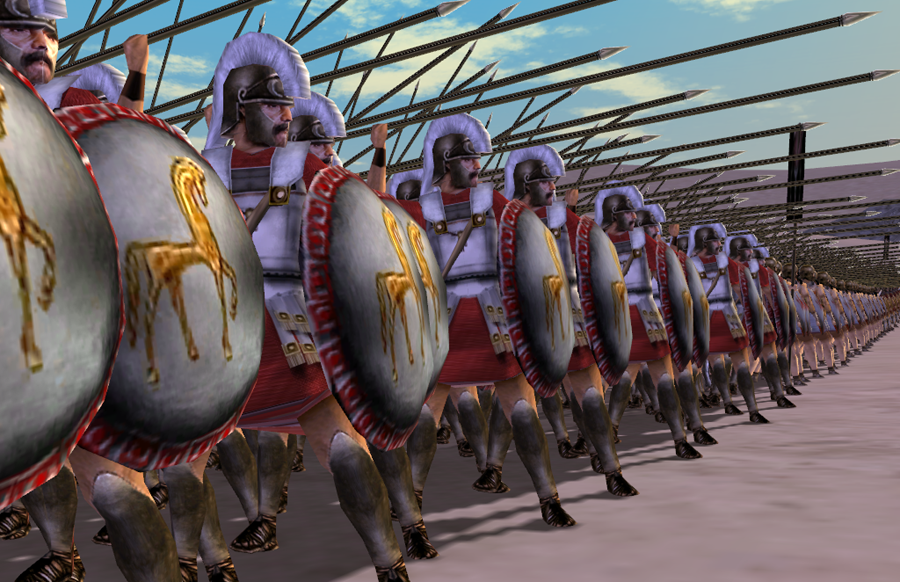
catw's Depiction of ancient carthaginian hoplites, about 300-250 BC. Notice the greek style crested helmet, and traditional horse symbol which adorned the shields. Armour made of hardened leather were from the time of the first punic war, as it was more complex to make but also lighter and allowed more flexibility. It became very popular.
About the Carthaginian, Liby-Punic and Libyan infantry
With that in mind, it is not surprising hat well-informed Carthaginians, trading with the Greeks, soon adopted this form of infantry, not only for carthage but soon also for their colonies own Carthaginian citizens, which in that case were called "liby-punic".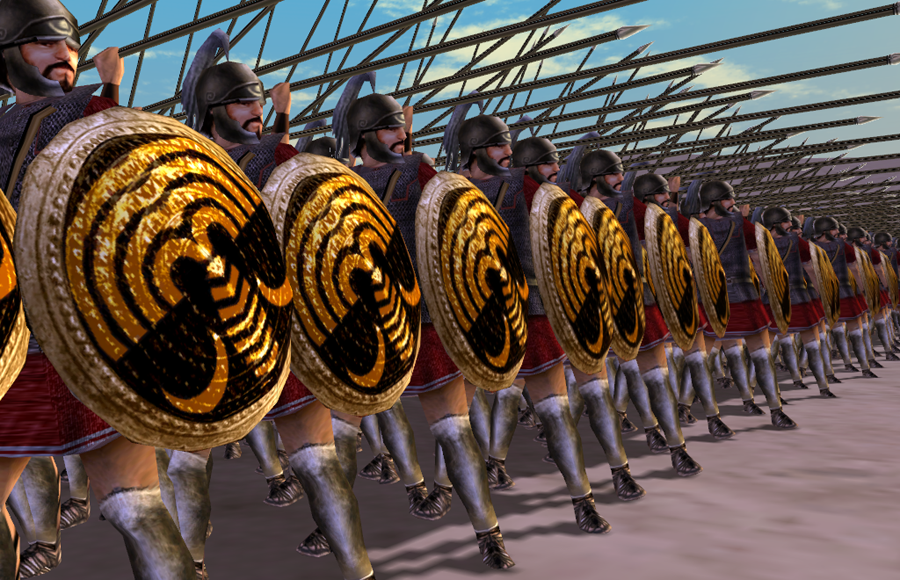
catw's Depiction of "modernized" carthaginian hoplites, third punic war (167 BC). A way hoplites would have survived that far is through citizen militias still using hoplons instead of thureos, or modern infantry that were given precious bronze hoplons instead of roman-style shields, but also adopted chainmail, like seen here. In a realistic way, they would have been not enough to form little more that a single unit, since they would have been likely be equipped with sarissas instead of dory.

catw's Depiction of the Thanit Sacred band, second punic war. As far as hoplites went, these was the absolute crack unit of the Carthaginian army. A single batallion, it was modelled after the Theban sacred batallion, which soundly defeated the Spartans.
About Hellenistic influence in the second Punic war (220 BC)
And indeed we know that after a while, the Carthaginians went from hoplitic to phalangist formations, with sarissae. The only clue we have about this evolution is the single phrase from Polybius about greek mercenaries training Hannibal's troops, described as having "long spears". So this was during the second Punic war and we don't know if this transition was total or partial (reserved to elites like the sacred Thanit batallion or veterans and picked-up units, whereas militia citizen still acted as hoplites). But given the fact these reforms were performed at Hannibal's camp we can only assume it was reserved to the core of his Carthaginian troops. At Zama when things went wrong they were engaged to the full and Polybius noted how fierce and skilled they can be in these conditions: "The two lines charged each other with the greatest fire and fury. Being nearly equal in numbers, spirit, courage, and arms, the battle was for a long time undecided, the men in their obstinate valour falling dead without giving way a step..." -Agreed this does not give a clue about the nature of their equipment. But it is clear that against the Roman legion of that era, only a phalanx was capable of dealing serious blows to the Romans, as it was shown many times during all the encounters of the Romans and Hellenistic strategos, from Pyrrhos to Perseus. Even the future governor of Greece, Flaminius described how splendid and formidable was the sight of a marching Lochoi (250 strong phalangist unit).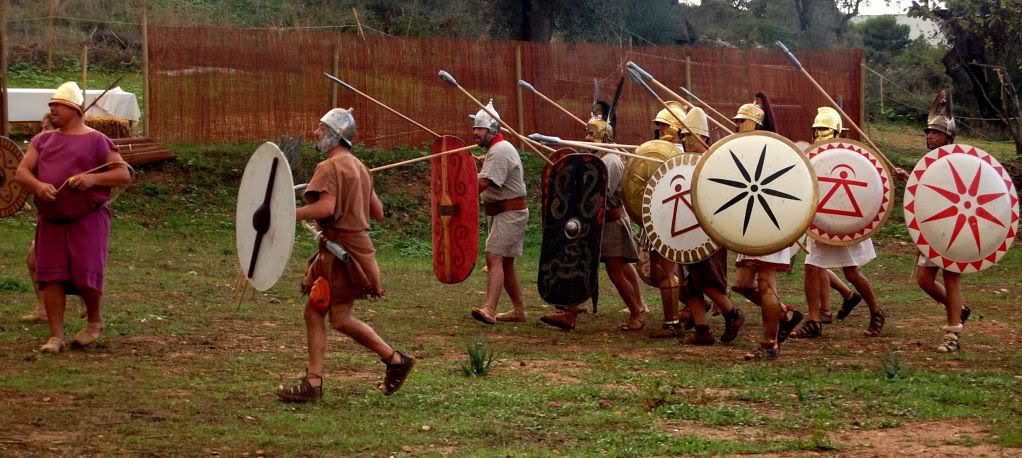
Carthaginian hoplite battle line reenacters of Ibercalafell assoc. - from romanarmytalk.com forum.
The third evolution: Romanized infantry (149–146 BC)
If the hopliti model, again could have been kept for militia citizens of colonial cities along the coast, Liby-Punic militia for example, just because of the lack of Thureos shields, their kit was probably the same: A tunic, possibly leather greaves for the luckiest, an old multiple-generation pointed or greek helmet, a sword (also for the luckiest) the traditional dory spear, and the wooden hoplon. We can perfectly imagin raised citizen militia units with thureos and hoplon mixed up depending on the local supplies, only working with basic orders and summary training. Meanwhile the upper class citizen army was likely to be better trained and keeping the hellenistic style of warfare, with sarissas. However we know that the Punic warriors followed the trends of the rest of the Hellenistic world and Romanized itself, with more versatile heavy troops protected by chainmail. Apart for their Greek-style helmets like the Thracian model in favor, and the use of spears, they were not that different to the Roman legions and a local version of the Greek Thorakitai. But hoplitic troops as said could have survived, just by the sake of the availability of the hoplon for lower class citizens. So pretty much until the destruction of Carthage and its civilization.
Rome II depiction of the Libyan militia hoplite.

Rome II depiction of the Liby-Punic hoplite.

Rome II depiction of the Carthaginian hoplite.

Rome II depiction of the Carthaginian late reformed hoplite.

Rome II depiction of the Carthaginian Sacred Band.

Hoplites in front of Carthage - Tunis, Steve Noon
Sources
Armies of the Carthaginian Wars 265–146 BC Men-at-Arms 121, Osprey Publishing - Terence Wise, Richard HookMilitary of Carthage (wikipedia article)
Osprey 2010- Carthaginian Warrior 264–146 BC - Nic Fields, Steve Noon
Carthaginian warfare on ancient.eu
♕ Aquitani & Vasci ♕ Celts ♕ Indo-greeks ♕ Veneti ♕ Yuezhi ♕ Indians ♕ Etruscans ♕ Numidians ♕ Samnites ♕ Judaean ♕ Ancient Chinese ♕ Corsico-Sardinians
⚔ Cingetos ⚔ Immortals ⚔ Cavaros ⚔ Cataphract ⚔ Romphaiorioi ⚔ Chalkaspidai ⚔ Devotio Warrior ⚔ Scythian Horse archer ⚔ The Ambactos ⚔ Iberian warfare ⚔ Illyrian warriors ⚔ Germanic spearmen ⚔ Carthaginian Hoplite ⚔ Thracian Peltast ⚔ Caetrati ⚔ Ensiferi ⚔ Hippakontistai ⚔ Hastati ⚔ Gaesatae ⚔ Cretan Archer ⚔ Thorakitai ⚔ Soldurii ⚔ Iphikrates ⚔ Kardaka ⚔ The thureophoroi